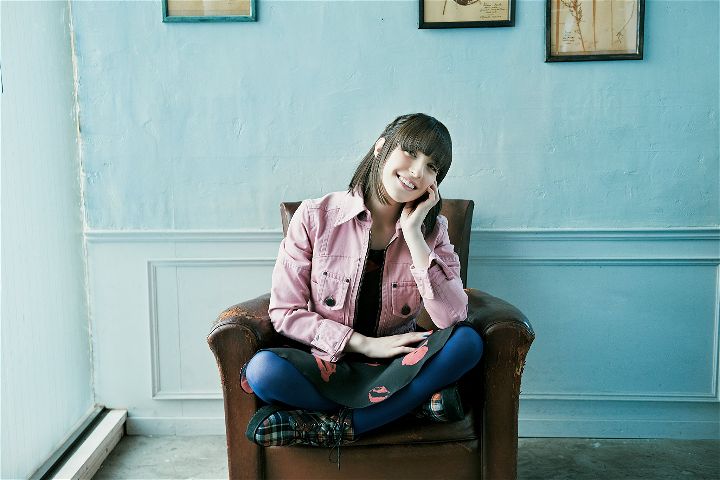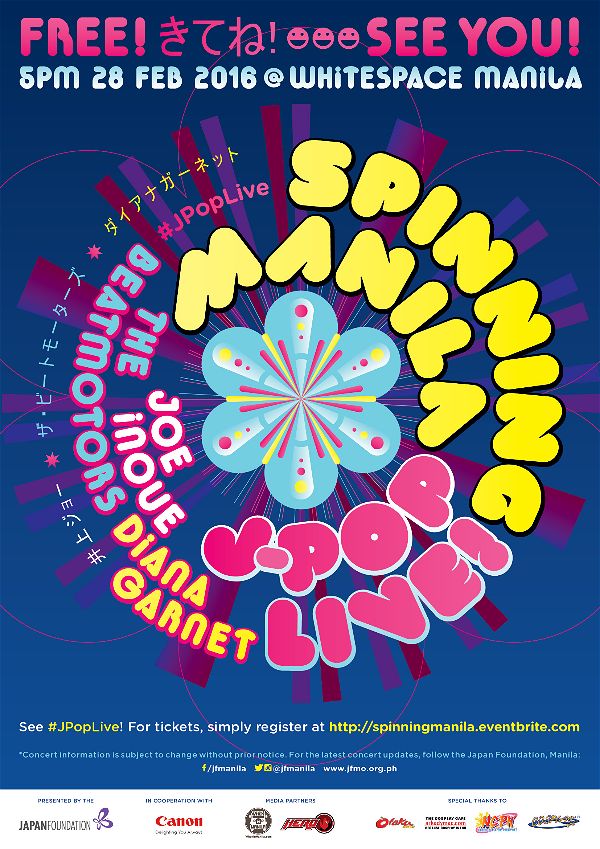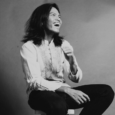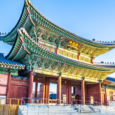On February 28, 2016 at Whitespace in Makati City, the Japan Foundation, Manila (JFM) presents Spinning Manila: J-Pop Live! – a J-Pop concert that brings together Diana Garnet, singer of Spinning World the ending theme song of Naruto: Shippuden, Joe Inoue, singer of Closer which was also used in the same anime series, and THE BEATMOTORS, an upcoming rock band from Japan.
Diana and Joe are both inspirational role models for learners of Japanese language. Whereas Joe is the son of Japanese parents who migrated in America, Diana is completely American who fell in love with Japanese through the influence of her own parents’ love for Japanese culture. Since it will be her first time in Manila, JFM asked Diana a few questions about her journey to learning Japanese and becoming a J-Pop star.

Tell us a bit about yourself and your journey to becoming a J-Pop singer.
“It started at home with my family when I was very young. My father in particular loves anime so as a family activity, he’d come home early from work one night a week and we’d watch anime together. To me this was the same as watching Disney movies with my family; it was a given. Like all little kids, the music I listened to tended to be the soundtracks of whatever movies or shows I watched with my parents, meaning anisong (anime song) and J-pop were an everyday part of my life. I’ve always really loved the powerful high-toned vocals in the 90’s anisong singers’ voices and the positive messages the lyrics held.
I think it was the Magic Knights Rayearth opening “Yuzurenai Negai” from Tamura Naomi that really hit me though. There was something about her charismatic, powerful voice, the gripping melody, and the lyrics’ positivity in the face of adversity that inspired me to think “Wow! I really need to become part of this world.” I was about 7 and it was then that I decided that this was the kind of music I wanted to sing. At the time I didn’t really think about how to live in Japan or even really understand that it was a different country on the other side of the world.
Throughout primary school, I sung classical opera competitively because of my mother’s influence, but starting junior and high school I switched over entirely to J-pop, taking part in any convention contests I could find and singing everyday at home. I lived with only my father then and he came home late from work most nights so I was able to sing for hours uninterrupted. I really appreciate that my parents were both very supportive of my interests and allowed me to pursue them as long as I also studied hard in school. Without their support I don’t think I’d have had the courage or confidence to move to another country and pursue a music career.
In high school I studied abroad in Japan for the first time for one year to immerse myself in the Japanese language and understand more about the culture. It really solidified that I would like to live in Japan permanently. In University, I again studied abroad, this time seeking out and participating in local karaoke contests as well as starting a band with a few college friends. After graduating University in the US, I came to Japan once again, this time as an English teacher. I still had a long way to go before I could feasibly make a career out of music, so while teaching I continued performing with my band, started covering Japanese songs online, and even began freelance singing and voice acting on the side – whatever I could find, English or Japanese. Anything to expand my portfolio and repertoire and to give me a little more exposure and experience as a professional.
Finally I was able to find the TV show, “Nodojiman the World!” which led me to meeting my current management here at Sony. I was able to transition into a full time musician from there. The process took years, a lot of planning, more than a few leaps of faith, and sometimes ending up in places I hadn’t initially considered as viable options. Despite the long and sometimes painful journey, it all came together in the end. The varied experiences have continued to tie aspects of my professional career together post-debut.
I’m still only at the very beginning of my career, so from here on, we’ll see where it goes!
How would you describe J-Pop in the context of the international music scene? What do you think is its appeal or selling points?
“The biggest appeal J-pop holds for me are the common themes of positivity and cooperation. J-pop is especially forward-thinking, particularly when contrasted with popular Western music which is often self-centric or focusing on breakups, being hurt by or hurting others, and other negative, uncooperative messages. Even when you do find one that seems positive, it’s often short-sighted or fleeting highs (such as partying or flings) rather than laying the groundwork for the future. While I think pain can create immensely powerful music and art and I sometimes greatly enjoy Western music, I also feel that it’s important to keep the message progressive and hopeful. I feel J-pop is the master of that. The underlying themes skew towards hope and positivity, even when being born of negative emotions. It’s not that the difficult emotions aren’t discussed, it’s that they’re portrayed with a light at the end of the tunnel. You find this reflected in other popular media from Japan as well (such as anime or manga) and I believe that’s one reason it’s able to touch many people from so many walks of life. I feel that the message of progression and inclusion are hugely influential on how a person views the world in the face of hardship. I believe media (and music in particular) are all forms of communication. You share your perspective with others in hopes that it resonates and they can share that feeling or work through their own. It’s an inherent want to understand and be understood. If that message is a positive one, I feel like it could potentially inspire others to do the same.
The other powerful aspect of J-Pop is the “anything goes” mentality when it comes to genre. Nothing is too boxed in or left as-is. Rather, many artists dabble in anything that catches their fancy, allowing for some seriously interesting new sounds. Even within just “popular music” there are aspects of many genres. Various ethnic influences grace the composition of varied artists such as Kanno Youko, Kajiura Yuki, Yuzu, or Porno Graffiti. Many artists like Ikimonogakari and Juju use jazz and big-band era influences to express complex emotions through a simultaneously upbeat and nostalgic atmosphere. Even rap and rock musicians use other genres to create new tones and layer various emotions for their genres. You’ll also find folk artsits such as Hajime Chitose singing songs for anime and anisong or idol singers such as Mizuki Nana and Shokotan borrowing from folk styles. It’s all very exciting and refreshing and allows for many avenues of expression.”
How about your kind of music? What do you think makes you different from other pop stars in Japan?
“This is where the “anything goes” idea really comes into play. I believe that the perspective I have to offer the J-pop community is one that doesn’t currently exist in the industry. Until now I’ve always been on the outside looking in; I wasn’t raised in Japan and I’ve had to actively and deliberately seek out J-pop and other Japanese media, rather than passively. During which time I was immersed naturally in Western musical aesthetics, making for an eclectic set of skills and influences early on in life.
Though I’ve been around anime and J-pop from childhood, what you could get in the States, especially before the internet era, was extremely limited and not in “real time,” nor was it natural immersion. Very little anime was broadcast on US TV in the 90’s and none of the original opening songs were intact. Music that had nothing to do with anime was almost impossible to find until the digital era. This forced us to actively seek out imports and what we could find was often skewed towards the interests of the providers. Therefore, my appreciation comes from an entirely different angle and experience than to that of a native. One of near-desperation and varied influences as I attempted to close the common knowledge and cultural gap. This has made me more flexible in taste (I would listen to or watch literally anything I could get my hands on) and has left me with conscious drive to always seek out more.
I believe as an artist this flexibility is portrayed in my insatiable hunger to perfect various styles and techniques; To constantly and purposefully add new skills to my arsenal. While unconsciously immersed in Western musical aesthetics, I would consciously seek and emulate those of Japan.
There are many artists that take from various genres and personal experiences, but I feel that my sound offers a unique outside perspective and flexibility while still adhering to and appreciating J-Pop techniques and influence. I hope I can use that perspective to create a bridge for better understanding between Japan and the outside world; Something everyone will be able to enjoy and relate to.”
What are your expectations from the international audience, now that you’re starting to have concerts abroad?
“That’s a surprisingly difficult question! The few times I’ve played abroad (London and Beijing,) I’ve found everyone very open and passionate. I’m aware that all people and communities are different though, so I try not to assume anything about anyone. I’d very much enjoy for the international community to continue being positive, open-minded, and to continue loving what they love. If I could at all inspire people or reach their hearts, that’d be the best thing I could ask for.”
You mentioned in a previous interview that Japan has great assets, not only anime but culture and history. Can you share a bit more about that perspective?
“Japan is a country with its own folklore and history, independent and periodically isolated from the rest of the world. As such, Japan had periods where it developed internally meaning there’s a wealth of rich culture and historical aesthetics that continue to influence Japan in the present era. Each era of Japanese history has an overall aesthetic; The Heian period’s gaudy opulence of the aristocracy – the “mono no aware,” or, the “pathos” and appreciation of the fleeting moment. The warring states period’s “zen” and stoic, minimalist aesthetics that so contrasted the previous era’s excess. The vitality, or “iki,” of the bourgeoisie artisan class in the politically stable Edo period (notably the first time culture wasn’t trickle-down but rather bottom-up in influence as the artisan class became economically relevant.) Even the Meiji, Taisho, and Showa periods all had their own flavour; From the fever of industrialisation to the new-money bubble of the 90’s …All of these individual cultural aesthetics are still reflected in Japanese storytelling and tastes today. It’s a small but rich melting pot of various outside influences, picked and chosen for their positive assets, followed by inward explorations, modification, and progression.
I found early on that learning more about Japanese history and the cultural and historical significance of the various eras is important to understanding and appreciating more about today’s Japanese popular culture. Understanding what led to various developments, preferences, and tastes becomes increasingly exciting as you’re able to identify those influences in the world around you. Even looking upon the same scenery with newfound knowledge can allow you to see, hear, taste, and feel it in a completely new way.
I still have a lot to learn, but life itself is a constantly evolving state. Being able to see and appreciate new perspectives is a great way to understand more about the world and yourself, to make deeper connections to both your interests and those around you.”
Let’s talk about your Nihongo fluency. How long have you been studying the language?
“I’ve never really studied Japanese traditionally in a classroom setting. Even in University my major was East Asian Anthropology and not Japanese language. I happened to listen to a lot of Japanese growing up so intonation came pretty naturally. The rest I supplemented through conversation (while studying abroad) and media (like watching anime and reading manga.)”
You speak so fluently that you could be considered a native! Can you share with us some tips, maybe your top three tips, in learning Nihongo? We’re sure many Filipino Nihongo learners would really love to learn from you.
“Haha, well, I don’t think my Japanese is anywhere near native (I often make the joke that I’m 「永遠に勉強中」or “forever going to be studying”) but sure!
At least when it comes to intonation, I can’t think of any tool more useful than music. I hear karaoke is really popular in the Philippines (and in my opinion, some of the best singers in the world are from here!) I recommend mimicking anisong or J-Pop artists in karaoke. Recording yourself and listening back for changes will both improve your intonation and singing skills!
My second recommendation is to use Japanese practically wherever you can. Nothing beats actually using it in your daily life. When I was back in the US I would often talk to my pets or the TV in Japanese to practice. Listening to Japanese as much as possible and trying to formulate your own opinions out loud is very important (even if you look crazy yelling at anime.) When in Japan I try to converse as much as possible with those around me about as many subjects as I can for a more balanced skill set. I’m sure my friends and management get tired of being asked questions sometimes though XD
Personally my weakest subject in Japanese in Kanji. I love reading so this fact pains me greatly. I just can’t seem to remember them no matter how much I drill, write, or read them. I’ve noticed for me that “association” seems to work the best. Associate a particular kanji with a name, place, or a story and then it sticks with you. When I read, I try and remember a kanji by the person who used it or the scene it was used in. It’s easier when the kanji is used in the name of a person or place.
Kanji is difficult because one kanji will have tons of readings depending on how or used or what other kanji it’s used with though… Ack. My best advice is just to keep at it daily!”
What are your plans for the future? What’s next after Naruto and Tantei Team KZ Jine Note?
“From here I would really like to branch out and be able to hit an even broader demographic. I really like anime and of course I would love to be a part of more genres and delve deeper into those projects, perhaps with more of a hand in production from time to time. It would also be interesting to maybe try my hand at various other media that might hit other demographics and later tie those back into music. Japan has a wealth of media outlets such as variety or talk shows, printed media like manga and novels, as well as various forms of art and comedy. I’d like to be able to incorporate many of those things into my career to create a new genre of entertainment that could hopefully inspire many people and expose them to other aspects of Japan perhaps they’d never previously had access to. Both internally and on international platforms, I’d like to be able to educate and inspire through accessibility.”
What advice can you give to aspiring pop stars in general?
“Make something only you can do! Your individual perspective and story is paramount. The entertainment industry is different for everybody but it’s important to keep persevering and working hard. You never know what paths will open for you, so keep an open mind and be prepared to try new things!”
Do you have a message to your fans in the Philippines?
“irst off, Hi! I’m super excited to get the chance to meet everyone! I’ve really been looking forward to going to the Philippines and meeting both long time friends from the area as well as having the opportunity to meet many new friends while I’m there! I hope you’ll all enjoy the event and I’ll see you soon! ^^)/”
Diana, Joe, and the Beatmotors are all appearing at Nihongo Fiesta 2016 at the Shangri-La Plaza Mall, Mandaluyong City on February 27, 2016 before their concert at Whitespace Manila on the next day. Admission to both events is free so feel free to join us all there!





